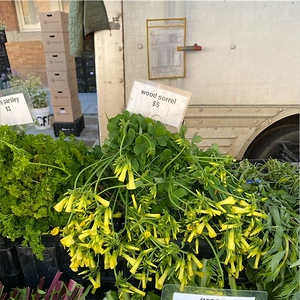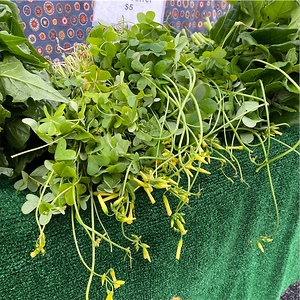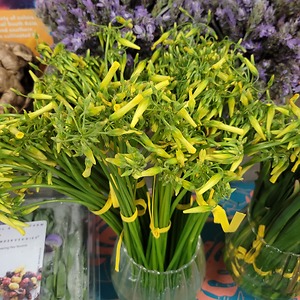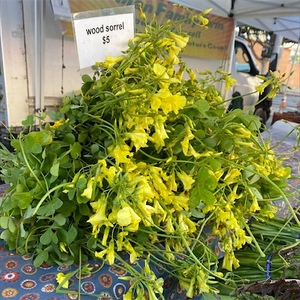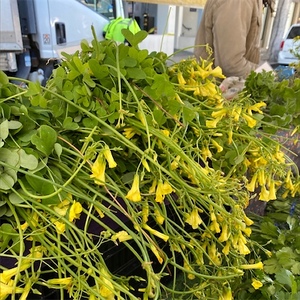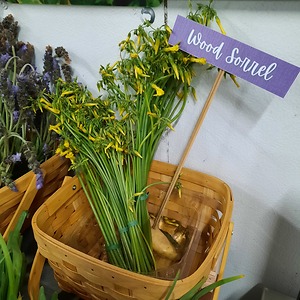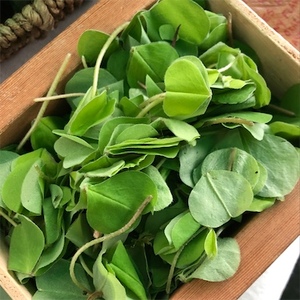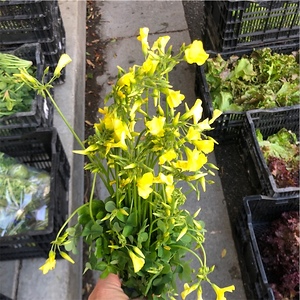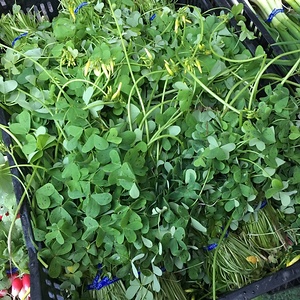


Wood Sorrel
Estimated Inventory, lb : 0
Description/Taste
Wood Sorrel is an edible weed that reaches between 10 and 35 centimeters in height and spreads through underground horizontal stems or rhizomes. It has delicate, reddish-green stems and bright green, heart-shaped leaves that cluster in groups of three on a single stem. The flowers range from white to yellow, or even violet purple, depending on the variety. The flowers, stems, and leaves are all edible, offering a refreshing and mild tart flavor comparable to lemons or apple peels.
Seasons/Availability
Wood Sorrel is generally available in early spring through fall, though it can be found year-round in warmer climates.
Current Facts
Wood Sorrel refers to many nearly-identical species in the Oxalis genus of the Oxalidaceae family. They are known as Wood Sorrels because of their tangy flavor, reminiscent of true sorrels in the Polygonaceae family, to which Wood Sorrels are only distantly related. In fact, the word “sorrel” is derived from the old French word for “sour,” while the botanical name, Oxalis, comes from the Greek word for “acidic.” It’s no surprise then that Wood Sorrel is commonly nicknamed Sour Grass. Pictured above is Yellow Wood Sorrel, Oxalis stricta, just one of many species found wild in North America. Common Wood Sorrel, or Oxalis acetosella, is more typical in Europe and parts of Asia and is distinguished by its white flowers.
Nutritional Value
Wood Sorrel is rich in vitamin C and has historically been used to treat scurvy. It is also a good source of beta carotene and flavonoids and contains oxalic acid, which is responsible for its tangy flavor. It is important to note that oxalic acid is considered toxic when consumed in large quantities as it inhibits nutrient absorption, notably calcium. While it is potentially risky for those suffering from kidney disease, arthritis, or gout, it is not considered a problem for the average person when consumed moderately, as it’s quite unlikely that enough would be eaten to be considered dangerous. Many common foods contain small amounts of oxalic acid, from spinach and broccoli to chocolate and coffee.
Applications
Wood Sorrel is best used fresh and is often picked by hikers as a thirst-quenching snack, thanks to its lemon-like flavor. To harvest, pull the plant up by the roots and reserve the flowers, leaves, and small wispy stems, discarding the larger stems as they can become tough and woody. The flowers and leaves offer a light citrusy flavor and can be added to cooked dishes like soups, frittatas, or casseroles, sprinkled on green or grain-based salads, or blended with butter for coating baked or roasted fish and vegetable dishes. Steep in hot water to brew a lemony-flavored tea, or dry the leaves and stems, crush with a mortar and pestle, then mix with sugar to make a lemon-free lemonade powder that can be dissolved in water as a refreshing drink. Wood Sorrel can even be used as a substitute in recipes calling for French or garden sorrel. It pairs well with hard cheeses, cream, eggs, fish, caviar, oysters, lentils, potatoes, spinach, onion, shallot, mustard, parsley, tarragon, mint, chervil, and nutmeg. The flowers can even be used to make yellow, orange, and red to brown-colored dyes. It is recommended to use the flowers and leaves immediately for the best quality and flavor.
Ethnic/Cultural Info
Native Americans traditionally used Wood Sorrel for medicinal purposes. The leaves would be chewed to alleviate nausea, mouth sores, and sore throats or brewed into a tea to combat fevers, scurvy, and urinary infections. They could even be fashioned into poultices to treat sores and ulcers. In Ireland, it is widely suspected that Wood Sorrel was the plant used by St. Patrick to demonstrate the Holy Trinity to the people of Ireland. Although the term “shamrock” comes from a Gaelic word meaning "little clover," many Wood Sorrel and clover species alike have been labeled and sold as shamrocks, a term that does not actually refer to a specific scientific species but rather a unique appearance—plants whose leaves are divided into three leaflets. Still, many argue that a true shamrock must be a three-leafed clover of the Trifolium genus in the pea family, hence Wood Sorrel is often dubbed as a “False Shamrock.”
Geography/History
Wood Sorrel is native to North America and parts of Eurasia. It thrives in partial shade with moderate rainfall and is an incredibly hardy perennial, considered an aggressive weed, that can sprout up in almost any condition, even nutritionally poor soil. It is particularly prevalent on forest floors, often growing near wild violets, cleavers, and onions. It can also be found in woodlands, meadows, roadsides, waste areas, yards or gardens. Yellow Wood Sorrel, featured in the photograph above, is one of the more common varieties growing wild across Canada and nearly all states of the United States, although it is most plentiful along the eastern United States into Canada. Wood Sorrel can be foraged from the wild in its native regions or found in specialty stores and markets.
Recipe Ideas
Recipes that include Wood Sorrel. One



